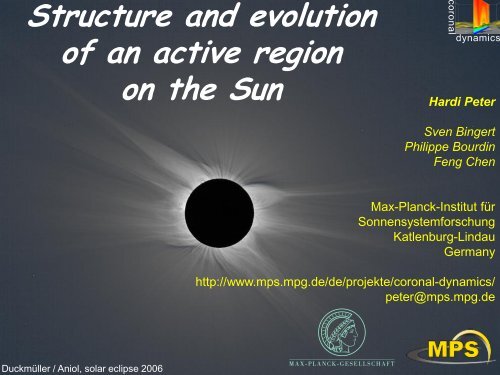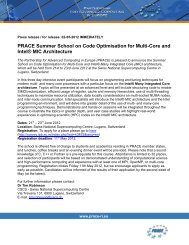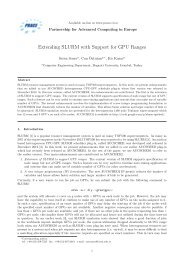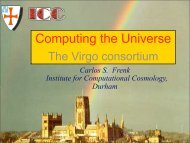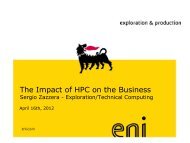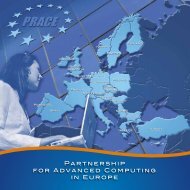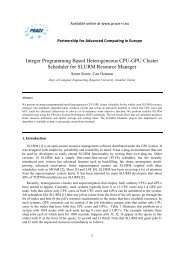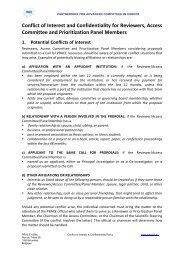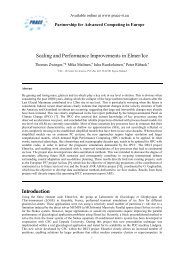Structure and evolution of an active region on the - prace
Structure and evolution of an active region on the - prace
Structure and evolution of an active region on the - prace
You also want an ePaper? Increase the reach of your titles
YUMPU automatically turns print PDFs into web optimized ePapers that Google loves.
Duckmüller / Aniol, solar eclipse 2006<br />
<str<strong>on</strong>g>Structure</str<strong>on</strong>g> <str<strong>on</strong>g><str<strong>on</strong>g>an</str<strong>on</strong>g>d</str<strong>on</strong>g> <str<strong>on</strong>g>evoluti<strong>on</strong></str<strong>on</strong>g><br />
<str<strong>on</strong>g>of</str<strong>on</strong>g> <str<strong>on</strong>g>an</str<strong>on</strong>g> <str<strong>on</strong>g>active</str<strong>on</strong>g> <str<strong>on</strong>g>regi<strong>on</strong></str<strong>on</strong>g><br />
or<strong>on</strong>al<br />
dynamics<br />
<strong>on</strong> <strong>the</strong> Sun<br />
Hardi Peter<br />
Sven Bingert<br />
Philippe Bourdin<br />
Feng Chen<br />
Max-Pl<str<strong>on</strong>g>an</str<strong>on</strong>g>ck-Institut für<br />
S<strong>on</strong>nensystemforschung<br />
Katlenburg-Lindau<br />
Germ<str<strong>on</strong>g>an</str<strong>on</strong>g>y<br />
http://www.mps.mpg.de/de/projekte/cor<strong>on</strong>al-dynamics/<br />
peter@mps.mpg.de
The cor<strong>on</strong>a <str<strong>on</strong>g>of</str<strong>on</strong>g> <strong>the</strong> Sun<br />
> 1 000 000 K<br />
visible<br />
surface:<br />
5800 K<br />
How c<str<strong>on</strong>g>an</str<strong>on</strong>g> a cool body<br />
heat its hot surroundings ?!<br />
EUV / X-rays:<br />
plasma at<br />
> 10 6 K<br />
solar eclipse 13.11.2012
25.-27.<br />
May 2013<br />
EUV (17.1 nm)<br />
Fe 8+ ca. 10 6 K<br />
The Sun over two days<br />
SDO / AIA<br />
visible light:<br />
solar surface<br />
with sunspots<br />
SDO / HMI
Cor<strong>on</strong>al structure: mostly cor<strong>on</strong>al loops<br />
AIA 17.1 nm<br />
Fe 8+ – 10 6 K<br />
– what determines <strong>the</strong> structure <str<strong>on</strong>g><str<strong>on</strong>g>an</str<strong>on</strong>g>d</str<strong>on</strong>g> dynamics ?<br />
– how is <strong>the</strong> cor<strong>on</strong>a heated ?<br />
→ close link between models <str<strong>on</strong>g><str<strong>on</strong>g>an</str<strong>on</strong>g>d</str<strong>on</strong>g> observati<strong>on</strong>s<br />
11.Feb.2013<br />
02:07:35 UT
B z [Gauss]<br />
Cor<strong>on</strong>al structure: mostly cor<strong>on</strong>al loops<br />
cor<strong>on</strong>a ~10 6 K<br />
AIA 17.1 nm<br />
Fe 8+ – 10 6 K<br />
surface ~6000 K<br />
+500<br />
surface magnetic field<br />
0<br />
–500<br />
11.Feb.2013<br />
02:07:35 UT
Erupti<strong>on</strong> <str<strong>on</strong>g><str<strong>on</strong>g>an</str<strong>on</strong>g>d</str<strong>on</strong>g> splash-down – “Arschbombe”<br />
3 hours – SDO / AIA 21.1 nm – 2 MK
“Normal” variability <str<strong>on</strong>g>of</str<strong>on</strong>g> <strong>the</strong> cor<strong>on</strong>a<br />
SDO / AIA / NASA<br />
30.Aug.2010<br />
2 hours<br />
SDO / AIA 17.1 nm –<br />
1 MK
The driver at <strong>the</strong> surface I: magneto-c<strong>on</strong>vecti<strong>on</strong><br />
Luc Rouppe v<str<strong>on</strong>g>an</str<strong>on</strong>g> der Voort,<br />
Swedish 1-m Solar Telescope (SST), La Palma<br />
2 Jul. 2010, 396.8 nm<br />
~1 hour<br />
loops in a<br />
stable <str<strong>on</strong>g>active</str<strong>on</strong>g> <str<strong>on</strong>g>regi<strong>on</strong></str<strong>on</strong>g><br />
Earth to scale<br />
45 x 35 Mm 2
The driver at <strong>the</strong> surface II: flux emergence<br />
Cheung & DeRosa (2012)<br />
ApJ 757, 147<br />
B z [Gauss]<br />
magnetogram<br />
~4 days<br />
loop formati<strong>on</strong> in <str<strong>on</strong>g>an</str<strong>on</strong>g><br />
emerging <str<strong>on</strong>g>active</str<strong>on</strong>g> <str<strong>on</strong>g>regi<strong>on</strong></str<strong>on</strong>g><br />
+1000<br />
0<br />
350 x 200 arcsec 2 = 250 x 150 Mm 2<br />
–1000<br />
Earth to scale
model introducti<strong>on</strong><br />
loops in<br />
a stable <str<strong>on</strong>g>active</str<strong>on</strong>g> <str<strong>on</strong>g>regi<strong>on</strong></str<strong>on</strong>g><br />
loop formati<strong>on</strong> in<br />
emerging <str<strong>on</strong>g>active</str<strong>on</strong>g> <str<strong>on</strong>g>regi<strong>on</strong></str<strong>on</strong>g>
C<strong>on</strong>cept for cor<strong>on</strong>al heating<br />
► horiz<strong>on</strong>tal moti<strong>on</strong>s in photosphere as driver<br />
→ field-line braiding<br />
(Parker 1972, ApJ 174, 499)<br />
→ flux-tube tect<strong>on</strong>ics<br />
(Priest et al 2002, ApJ 576, 533)<br />
► <strong>the</strong>re is some observati<strong>on</strong>al evidence<br />
for field-line braiding<br />
Hi-C rocket<br />
high-resoluti<strong>on</strong> EUV imaging<br />
193 Å – Fe XII – 1.5 MK<br />
field-line<br />
braiding ?
How to c<strong>on</strong>struct a cor<strong>on</strong>a in <strong>the</strong> box…<br />
horiz<strong>on</strong>tal y<br />
► take observed magnetogram:<br />
→ surface magnetic field B 0<br />
surface magnetic field<br />
horiz<strong>on</strong>tal x
How to c<strong>on</strong>struct a cor<strong>on</strong>a in <strong>the</strong> box…<br />
Dutch Open Telescop / P.Sütterlin<br />
► take observed magnetogram:<br />
→ surface magnetic field B 0<br />
► extrapolate B 0 to fill box<br />
assume “1D” atmosphere<br />
► surface c<strong>on</strong>vecti<strong>on</strong>:<br />
gr<str<strong>on</strong>g>an</str<strong>on</strong>g>ulati<strong>on</strong> drives magnetic field<br />
► “fieldline braiding”:<br />
currents induced in cor<strong>on</strong>a<br />
j = (∇x B) / h<br />
surface c<strong>on</strong>vective flow / gr<str<strong>on</strong>g>an</str<strong>on</strong>g>ulati<strong>on</strong>
How to c<strong>on</strong>struct a cor<strong>on</strong>a in <strong>the</strong> box…<br />
Gudiksen & Nordlund (2002) ApJ 572, L113<br />
► take observed magnetogram:<br />
→ surface magnetic field B 0<br />
► extrapolate B 0 to fill box<br />
assume “1D” atmosphere<br />
► surface c<strong>on</strong>vecti<strong>on</strong>:<br />
gr<str<strong>on</strong>g>an</str<strong>on</strong>g>ulati<strong>on</strong> drives magnetic field<br />
histogram <str<strong>on</strong>g>of</str<strong>on</strong>g> currents<br />
Bingert et al (2006)<br />
► “fieldline braiding”:<br />
currents induced in cor<strong>on</strong>a<br />
j = (∇x B) / h<br />
me<str<strong>on</strong>g>an</str<strong>on</strong>g> B 2<br />
current log 10 J 2<br />
heating through Ohmic dissipati<strong>on</strong>:<br />
h j 2 ~ exp(- z/H )<br />
me<str<strong>on</strong>g>an</str<strong>on</strong>g> J 2<br />
loop-structured 10 6 K cor<strong>on</strong>a<br />
vertical z [ Mm]
Magnetohydrodynamics (MHD)
Br<str<strong>on</strong>g><str<strong>on</strong>g>an</str<strong>on</strong>g>d</str<strong>on</strong>g>enburg & Dobler (2002)<br />
Comp. Phys. Comm., 147, 471<br />
Pencil code<br />
designed for<br />
compressible turbulent MHD flows<br />
wide r<str<strong>on</strong>g>an</str<strong>on</strong>g>ge <str<strong>on</strong>g>of</str<strong>on</strong>g> applicati<strong>on</strong>s<br />
high-order explicit finite difference<br />
high-order Runge-Kutta time stepping<br />
n<strong>on</strong>-equidist<str<strong>on</strong>g>an</str<strong>on</strong>g>t grids<br />
highly modular<br />
extensi<strong>on</strong>s to st<str<strong>on</strong>g><str<strong>on</strong>g>an</str<strong>on</strong>g>d</str<strong>on</strong>g>ard MHD<br />
– Spitzer heat c<strong>on</strong>ducti<strong>on</strong><br />
– radiative losses / radiative tr<str<strong>on</strong>g>an</str<strong>on</strong>g>sfer<br />
– particles<br />
– eight moment approximati<strong>on</strong><br />
– …<br />
http://pencil-code.googlecode.com/<br />
freely available<br />
over 100 c<strong>on</strong>tributors world wide<br />
tested <strong>on</strong> m<str<strong>on</strong>g>an</str<strong>on</strong>g>y platforms<br />
large set <str<strong>on</strong>g>of</str<strong>on</strong>g> samples included<br />
Tools for visualizati<strong>on</strong><br />
<str<strong>on</strong>g><str<strong>on</strong>g>an</str<strong>on</strong>g>d</str<strong>on</strong>g> data <str<strong>on</strong>g>an</str<strong>on</strong>g>alysis<br />
MPI parallelized<br />
scales well<br />
up to more th<str<strong>on</strong>g>an</str<strong>on</strong>g> 80.000 cores<br />
scaling for cor<strong>on</strong>al models<br />
P e n c i l
Model <str<strong>on</strong>g><str<strong>on</strong>g>an</str<strong>on</strong>g>d</str<strong>on</strong>g> observati<strong>on</strong>s<br />
3D MHD model:<br />
T, r, v, B<br />
syn<strong>the</strong>sized cor<strong>on</strong>al emissi<strong>on</strong> Mg X 625 Å<br />
density cut<br />
10 5 K isosurface<br />
spectral<br />
syn<strong>the</strong>sis<br />
photospheric<br />
magnetic field<br />
intensity map (inv.)<br />
Doppler map<br />
Bingert & hp (2011) A&A 530, A112<br />
hp (2010) A&A 521, A51<br />
compare<br />
real observati<strong>on</strong>s<br />
comparis<strong>on</strong><br />
Hinode / EIS Fe XV 284 Å<br />
160”x125”
model introducti<strong>on</strong><br />
loops in<br />
a stable <str<strong>on</strong>g>active</str<strong>on</strong>g> <str<strong>on</strong>g>regi<strong>on</strong></str<strong>on</strong>g><br />
loop formati<strong>on</strong> in<br />
emerging <str<strong>on</strong>g>active</str<strong>on</strong>g> <str<strong>on</strong>g>regi<strong>on</strong></str<strong>on</strong>g>
A <strong>on</strong>e-to-<strong>on</strong>e <str<strong>on</strong>g>active</str<strong>on</strong>g> <str<strong>on</strong>g>regi<strong>on</strong></str<strong>on</strong>g> model<br />
Bourdin, Bingert, hp (2013)<br />
Hinode/SOT magnetogram<br />
– 14.Nov.2007, 12:15-18:00 UT<br />
– time-series: 90 s cadence<br />
EIS / Hinode raster sc<str<strong>on</strong>g>an</str<strong>on</strong>g><br />
– covering similar FOV<br />
– acquired during same time frame<br />
– full spectral pr<str<strong>on</strong>g>of</str<strong>on</strong>g>ile <str<strong>on</strong>g>of</str<strong>on</strong>g> m<str<strong>on</strong>g>an</str<strong>on</strong>g>y lines<br />
e.g. Fe XV (284 Å)
Bourdin, Bingert, hp (2013)<br />
A <strong>on</strong>e-to-<strong>on</strong>e model <str<strong>on</strong>g>of</str<strong>on</strong>g> <str<strong>on</strong>g>an</str<strong>on</strong>g> “old” <str<strong>on</strong>g>active</str<strong>on</strong>g> <str<strong>on</strong>g>regi<strong>on</strong></str<strong>on</strong>g><br />
3D MHD numerical model<br />
– 235 x 235 x 156 Mm 3 → full <str<strong>on</strong>g>active</str<strong>on</strong>g> <str<strong>on</strong>g>regi<strong>on</strong></str<strong>on</strong>g><br />
– 1024 x 1024 x 256 grid points<br />
– driven by observed velocities<br />
<str<strong>on</strong>g><str<strong>on</strong>g>an</str<strong>on</strong>g>d</str<strong>on</strong>g> observed photospheric magnetogram<br />
– r<str<strong>on</strong>g>an</str<strong>on</strong>g> <strong>on</strong> Curie <strong>on</strong> typically 4000 cores<br />
– ca. 8 M core hrs<br />
post processing:<br />
– syn<strong>the</strong>size emissi<strong>on</strong><br />
– spectral line syn<strong>the</strong>sis<br />
– field-line <str<strong>on</strong>g>evoluti<strong>on</strong></str<strong>on</strong>g><br />
EIS / Fe XV 284 Å<br />
observati<strong>on</strong>s: EIS / Fe XV 284 Å<br />
► cor<strong>on</strong>al loops<br />
form above<br />
well developed<br />
<str<strong>on</strong>g>active</str<strong>on</strong>g> <str<strong>on</strong>g>regi<strong>on</strong></str<strong>on</strong>g><br />
P e n c i l<br />
model: syn<strong>the</strong>sized Fe XV 284 Å
Model <str<strong>on</strong>g><str<strong>on</strong>g>an</str<strong>on</strong>g>d</str<strong>on</strong>g> observati<strong>on</strong>: intensity & Doppler shift<br />
Bourdin, Bingert, hp (2013)<br />
► reproduces hot core<br />
► <str<strong>on</strong>g>active</str<strong>on</strong>g> <str<strong>on</strong>g>regi<strong>on</strong></str<strong>on</strong>g> loops<br />
are in right places<br />
► less clear agreement<br />
in Doppler shifts<br />
► large loop<br />
does not show in full<br />
(more time<br />
would be needed)
Comparis<strong>on</strong> to stereoscopic observati<strong>on</strong>s<br />
positi<strong>on</strong> <str<strong>on</strong>g>of</str<strong>on</strong>g> observed loops<br />
determined by<br />
stereoscopic rec<strong>on</strong>structi<strong>on</strong><br />
match central field line<br />
<str<strong>on</strong>g>of</str<strong>on</strong>g> loops in model !
model introducti<strong>on</strong><br />
loops in<br />
a stable <str<strong>on</strong>g>active</str<strong>on</strong>g> <str<strong>on</strong>g>regi<strong>on</strong></str<strong>on</strong>g><br />
loop formati<strong>on</strong> in<br />
emerging <str<strong>on</strong>g>active</str<strong>on</strong>g> <str<strong>on</strong>g>regi<strong>on</strong></str<strong>on</strong>g>
Cor<strong>on</strong>al model driven by emerging flux simulati<strong>on</strong><br />
flux-emergence simulati<strong>on</strong><br />
(Cheung et al. 2010, ApJ 720, 233)<br />
– magnetic flux rope rises from bottom<br />
<str<strong>on</strong>g><str<strong>on</strong>g>an</str<strong>on</strong>g>d</str<strong>on</strong>g> breaks through surface<br />
Origin <str<strong>on</strong>g>of</str<strong>on</strong>g> sunspots<br />
9<br />
→ formati<strong>on</strong> <str<strong>on</strong>g>of</str<strong>on</strong>g> sunspot pair<br />
→ limited to interior <str<strong>on</strong>g><str<strong>on</strong>g>an</str<strong>on</strong>g>d</str<strong>on</strong>g> surface<br />
•Form<br />
sun
Chen, Bingert, hp, Schüssler<br />
Camer<strong>on</strong>, Cheung (2013)<br />
Cor<strong>on</strong>al model driven by emerging flux simulati<strong>on</strong><br />
our<br />
cor<strong>on</strong>al<br />
model<br />
interior<br />
model<br />
cor<strong>on</strong>al simulati<strong>on</strong>:<br />
– use photospheric layer (T, r, v, B)<br />
as time-dependent lower boundary<br />
→ magnetic field exp<str<strong>on</strong>g><str<strong>on</strong>g>an</str<strong>on</strong>g>d</str<strong>on</strong>g>s<br />
→ cor<strong>on</strong>al loops form<br />
P e n c i l<br />
3D MHD numerical model<br />
– 1024 x 512 x 512 grid points<br />
– temporal <str<strong>on</strong>g>evoluti<strong>on</strong></str<strong>on</strong>g> over 10 hours<br />
– runs <strong>on</strong> SuperMUC ~ 7 M core hrs<br />
– using 4000 cores<br />
post processing:<br />
– syn<strong>the</strong>tic<br />
cor<strong>on</strong>al emissi<strong>on</strong><br />
– field-line tracing<br />
23.0 hr<br />
25.2 hr<br />
27.2 hr
DN / pix / s B z [G]<br />
Cor<strong>on</strong>al model driven by emerging flux simulati<strong>on</strong><br />
syn<strong>the</strong>sized cor<strong>on</strong>al emissi<strong>on</strong> (1.5 10 6 K )<br />
► loops form at different places<br />
at different times<br />
► loop footpoints are in<br />
sunspot periphery (penumbra)<br />
view from top: B vert @ bottom + AIA 193 Å<br />
+3000<br />
0<br />
► loop fragments<br />
view from side: AIA 193 Å<br />
146 x 73 Mm 2<br />
–3000<br />
1000<br />
100<br />
10<br />
34 min<br />
out <str<strong>on</strong>g>of</str<strong>on</strong>g> 10 hrs<br />
Chen, Bingert, hp, Schüssler, Camer<strong>on</strong>, Cheung (2013)<br />
1
Cor<strong>on</strong>al model driven by emerging flux simulati<strong>on</strong><br />
P [ 10 6 W/m 2 ]<br />
count rate [ DN / pix / s ]<br />
► loops form at different places<br />
at different times<br />
► loop footpoints are in<br />
sunspot periphery (penumbra)<br />
► loop fragments<br />
► EUV loops form through<br />
increased heating:<br />
higher Poynting flux @ loop feet<br />
cor<strong>on</strong>al emissi<strong>on</strong> from top: AIA 193 Å<br />
vertical Poynting flux at bottom<br />
146 x 73 Mm 2<br />
1000<br />
100<br />
10<br />
1<br />
+10<br />
0<br />
Chen, Bingert, hp, Schüssler, Camer<strong>on</strong>, Cheung (2013)<br />
–5
Cor<strong>on</strong>al model driven by emerging flux simulati<strong>on</strong><br />
count rate [ DN / pix / s ]<br />
► loops form at different places<br />
at different times<br />
► loop footpoints are in<br />
sunspot periphery (penumbra)<br />
► loop fragments<br />
► EUV loops form through<br />
increased heating:<br />
higher Poynting flux @ loop feet<br />
► loop footpoints where<br />
str<strong>on</strong>gest stretching <str<strong>on</strong>g>of</str<strong>on</strong>g> B<br />
→ field-line braiding<br />
flux-tube tect<strong>on</strong>ics<br />
at work !<br />
cor<strong>on</strong>al emissi<strong>on</strong> from top: AIA 193 Å<br />
146 x 73 Mm 2<br />
horiz<strong>on</strong>tal stretching <str<strong>on</strong>g>of</str<strong>on</strong>g> B at bottom<br />
1000<br />
100<br />
| (B ∙∇) v | horiz. [G/s]<br />
Chen, Bingert, hp, Schüssler, Camer<strong>on</strong>, Cheung (2013)<br />
10<br />
1<br />
3<br />
2<br />
1<br />
0
Fragmentati<strong>on</strong> <str<strong>on</strong>g>of</str<strong>on</strong>g> cor<strong>on</strong>al structures<br />
observati<strong>on</strong><br />
our model (top view)<br />
146 x 73 Mm 2<br />
10 min<br />
later<br />
AIA 193 emissi<strong>on</strong>
C<strong>on</strong>clusi<strong>on</strong>s<br />
► field line braiding provides<br />
proper spatial <str<strong>on</strong>g><str<strong>on</strong>g>an</str<strong>on</strong>g>d</str<strong>on</strong>g> temporal distributi<strong>on</strong><br />
to heat <strong>the</strong> cor<strong>on</strong>a <str<strong>on</strong>g><str<strong>on</strong>g>an</str<strong>on</strong>g>d</str<strong>on</strong>g> drive its dynamics<br />
→ matching structures in model <str<strong>on</strong>g><str<strong>on</strong>g>an</str<strong>on</strong>g>d</str<strong>on</strong>g> observati<strong>on</strong>s<br />
→ underst<str<strong>on</strong>g><str<strong>on</strong>g>an</str<strong>on</strong>g>d</str<strong>on</strong>g>ing loop formati<strong>on</strong><br />
→ <str<strong>on</strong>g><str<strong>on</strong>g>an</str<strong>on</strong>g>d</str<strong>on</strong>g> m<str<strong>on</strong>g>an</str<strong>on</strong>g>y more... (Doppler shifts, variability, …)<br />
► HPC is pivotal<br />
to capture spatial <str<strong>on</strong>g><str<strong>on</strong>g>an</str<strong>on</strong>g>d</str<strong>on</strong>g> temporal complexity<br />
→ numerical experiments to test model ideas<br />
→ reveals which processes are at work<br />
► next steps<br />
→ more realistic match <str<strong>on</strong>g>of</str<strong>on</strong>g> individual structures<br />
→ investigate parameterizati<strong>on</strong> <str<strong>on</strong>g>of</str<strong>on</strong>g> heat input<br />
→ investigate different levels <str<strong>on</strong>g>of</str<strong>on</strong>g> activity (→ o<strong>the</strong>r stars)<br />
► new opportunities for comparis<strong>on</strong> to observati<strong>on</strong>s<br />
IRIS / NASA – Solar Orbiter / ESA – Solar-C / JAXA<br />
<str<strong>on</strong>g>Structure</str<strong>on</strong>g> <str<strong>on</strong>g><str<strong>on</strong>g>an</str<strong>on</strong>g>d</str<strong>on</strong>g> <str<strong>on</strong>g>evoluti<strong>on</strong></str<strong>on</strong>g><br />
<str<strong>on</strong>g>of</str<strong>on</strong>g> <str<strong>on</strong>g>an</str<strong>on</strong>g> <str<strong>on</strong>g>active</str<strong>on</strong>g> <str<strong>on</strong>g>regi<strong>on</strong></str<strong>on</strong>g> <strong>on</strong> <strong>the</strong> Sun
Beware <str<strong>on</strong>g>of</str<strong>on</strong>g> <strong>the</strong> m<strong>on</strong>ster !!


